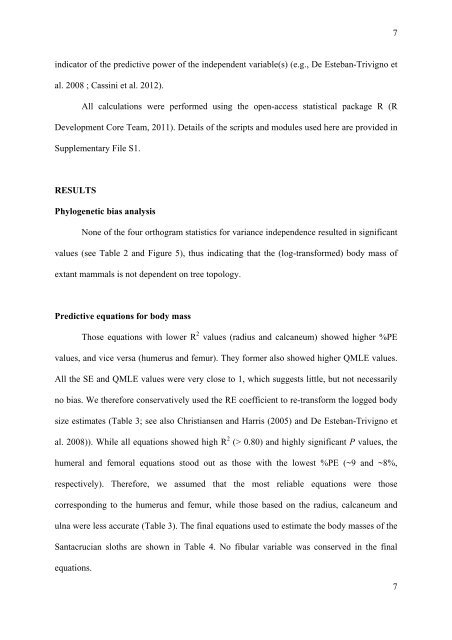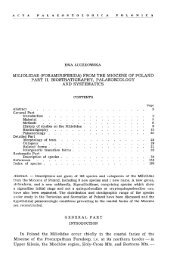Mass estimation in fossil sloths (Xenarthra, Folivora) from the Early ...
Mass estimation in fossil sloths (Xenarthra, Folivora) from the Early ...
Mass estimation in fossil sloths (Xenarthra, Folivora) from the Early ...
You also want an ePaper? Increase the reach of your titles
YUMPU automatically turns print PDFs into web optimized ePapers that Google loves.
<strong>in</strong>dicator of <strong>the</strong> predictive power of <strong>the</strong> <strong>in</strong>dependent variable(s) (e.g., De Esteban-Trivigno et<br />
al. 2008 ; Cass<strong>in</strong>i et al. 2012).<br />
All calculations were performed us<strong>in</strong>g <strong>the</strong> open-access statistical package R (R<br />
Development Core Team, 2011). Details of <strong>the</strong> scripts and modules used here are provided <strong>in</strong><br />
Supplementary File S1.<br />
RESULTS<br />
Phylogenetic bias analysis<br />
None of <strong>the</strong> four orthogram statistics for variance <strong>in</strong>dependence resulted <strong>in</strong> significant<br />
values (see Table 2 and Figure 5), thus <strong>in</strong>dicat<strong>in</strong>g that <strong>the</strong> (log-transformed) body mass of<br />
extant mammals is not dependent on tree topology.<br />
Predictive equations for body mass<br />
Those equations with lower R 2 values (radius and calcaneum) showed higher %PE<br />
values, and vice versa (humerus and femur). They former also showed higher QMLE values.<br />
All <strong>the</strong> SE and QMLE values were very close to 1, which suggests little, but not necessarily<br />
no bias. We <strong>the</strong>refore conservatively used <strong>the</strong> RE coefficient to re-transform <strong>the</strong> logged body<br />
size estimates (Table 3; see also Christiansen and Harris (2005) and De Esteban-Trivigno et<br />
al. 2008)). While all equations showed high R 2 (> 0.80) and highly significant P values, <strong>the</strong><br />
humeral and femoral equations stood out as those with <strong>the</strong> lowest %PE (~9 and ~8%,<br />
respectively). Therefore, we assumed that <strong>the</strong> most reliable equations were those<br />
correspond<strong>in</strong>g to <strong>the</strong> humerus and femur, while those based on <strong>the</strong> radius, calcaneum and<br />
ulna were less accurate (Table 3). The f<strong>in</strong>al equations used to estimate <strong>the</strong> body masses of <strong>the</strong><br />
Santacrucian <strong>sloths</strong> are shown <strong>in</strong> Table 4. No fibular variable was conserved <strong>in</strong> <strong>the</strong> f<strong>in</strong>al<br />
equations.<br />
7<br />
7
















